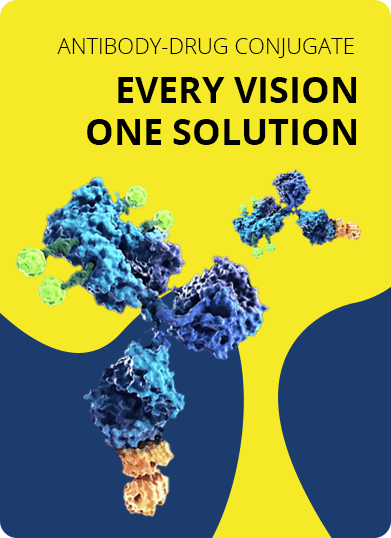- Home
- Applications
- Glioma
- Glioblastoma
ADC Development Services for Glioblastoma Research
Glioblastoma represents a highly heterogeneous group of neoplasms that are among the most aggressive and challenging cancers to treat. An improved understanding of the molecular pathways that drive malignancy in glioblastoma has led to the identification of several biomarkers and the development of targeting therapeutic strategies, such as antibody-drug conjugates (ADCs) specifically targeting tumor cells and the tumor microenvironment. With advanced technology platforms, Creative Biolabs provides customized ADC development services for glioblastoma to meet clients' requirements.
Introduction of Glioblastoma
Glioblastoma, a kind of high-grade brain tumor with poor prognosis, is the most aggressive tumor of all glioblastomas, exhibiting notable variability at the histopathological, epigenetic and genetic levels. Due to its multiple forms, it is also termed Glioblastoma multiforme (GBM). Glioblastoma is usually described in two different clinical forms, primary and secondary glioblastoma. Primary glioblastoma often has amplified, mutated epidermal-growth factor receptor (EGFR) which encodes altered EGFR (EGFRvIII) whereas secondary glioblastoma has increased signaling through platelet-derived growth factor (PDGF)-A receptor. Furthermore, primary glioblastoma has commonly amplification of MDM2, PTEN mutations and homozygous deletions of CDKN2A whereas secondary glioblastoma usually has more prevalent p53 mutations, IDH1 mutations, ATRX mutations, and overexpression of PDGFRA.
Currently, the standard approach in managing glioblastoma includes consideration of maximum surgical resection. Once recurrence occurs, therapeutic options are limited. For patients with recurrent glioblastoma, chemotherapy regimens are associated with overall response rates of 4-9%, 6-month progression-free survival (PFS) of 10-19%, and median overall survival durations of 5-10 months. The clinical presentations of glioblastoma include persistent weakness, numbness, loss of vision, or alteration of language. The typical imaging features of glioblastoma include an infiltrative, heterogeneous, ring enhancing lesion with central necrosis and surrounding peritumoral edema. The diagnosis of glioblastoma requires the histological and molecular genetic study of tumor tissue obtained during open tumor resection or biopsy. Morphologically, glioblastoma is defined as a glial brain tumor with features of malignancy that include angiogenesis and focal necrosis.
Current Therapies for Glioblastomas
Currently, there are few available therapeutic options for the treatment of glioblastomas. This lack of effective treatments has been linked to diverse factors, such as target selection, tumor heterogeneity and poor penetrance of therapeutic agents through the blood-brain barrier (BBB) and into tumors. Now, efforts for the research of glioblastomas treatment development are mainly focused on the following strategies:
- Targeting growth factor receptors and their downstream signaling pathways (EGFR/ EGFRvIII-targeted therapies)
- Targeting DNA repair and cell cycle control pathways
- Targeting epigenetic deregulation and tumor metabolism
- Targeting tumor angiogenesis
- Immunotherapies
Among them, therapies using mAbs alone or linked to cytotoxic payloads, have proved beneficial for patients with glioblastoma. Drugs directed against alterations that lead to constitutive activation of receptor tyrosine kinase (RTKs) are the most common type of targeted therapy in all types of cancer with successful responses including glioblastoma.
ADC-based Therapy for Glioblastoma
Cell-surface antigens expressed on glioblastoma cells that have proven resistant to signaling inhibition approaches-whether by tyrosine-kinase inhibitors or naked mAbs-are attractive targets for ADC therapeutics. Several converging lines of evidence have revived interest in using systemic delivery of ADCs to treat patients with glioblastoma, especially given the problems and toxicities associated with locoregional administration of immunotoxins and radio-immunotherapy. Studies have shown that anti-EGFR/EGFRvIII ADCs can deliver higher concentrations of cytotoxic agents in glioblastoma than can be achieved using systemic administration of the cytotoxic drug alone. Moreover, these ADCs have been shown to inhibit glioblastoma growth in vivo, using both heterotopic and orthotopic animal models.
What Can We Do for You?
With the advent of new formulations of ADCs, and in light of the encouraging activity in patients with other solid tumors, ADC have garnered renewed interest as treatments for glioblastoma. Creative Biolabs focuses on EFGR/EGFRvIII‑targeting ADC development for the treatment of glioblastoma. With years of experience in the development and manufacturing of mAbs, linker and payload, as well as antibody conjugation, Creative Biolabs now offers complete and fully integrated anti-glioblastoma ADC development services from antibody generation to final product for our clients.
ADCs are promising therapeutic agents currently in development for the treatment of glioblastoma. Creative Biolabs has effectively combined a series of emerging technologies to support the full spectrum of activities involved in ADC development. If you are interested in our ADC development services for glioblastoma, please feel free to contact us for more information.
For Research Use Only. NOT FOR CLINICAL USE.

Online Inquiry
Welcome! For price inquiries, please feel free to contact us through the form on the left side. We will get back to you as soon as possible.
